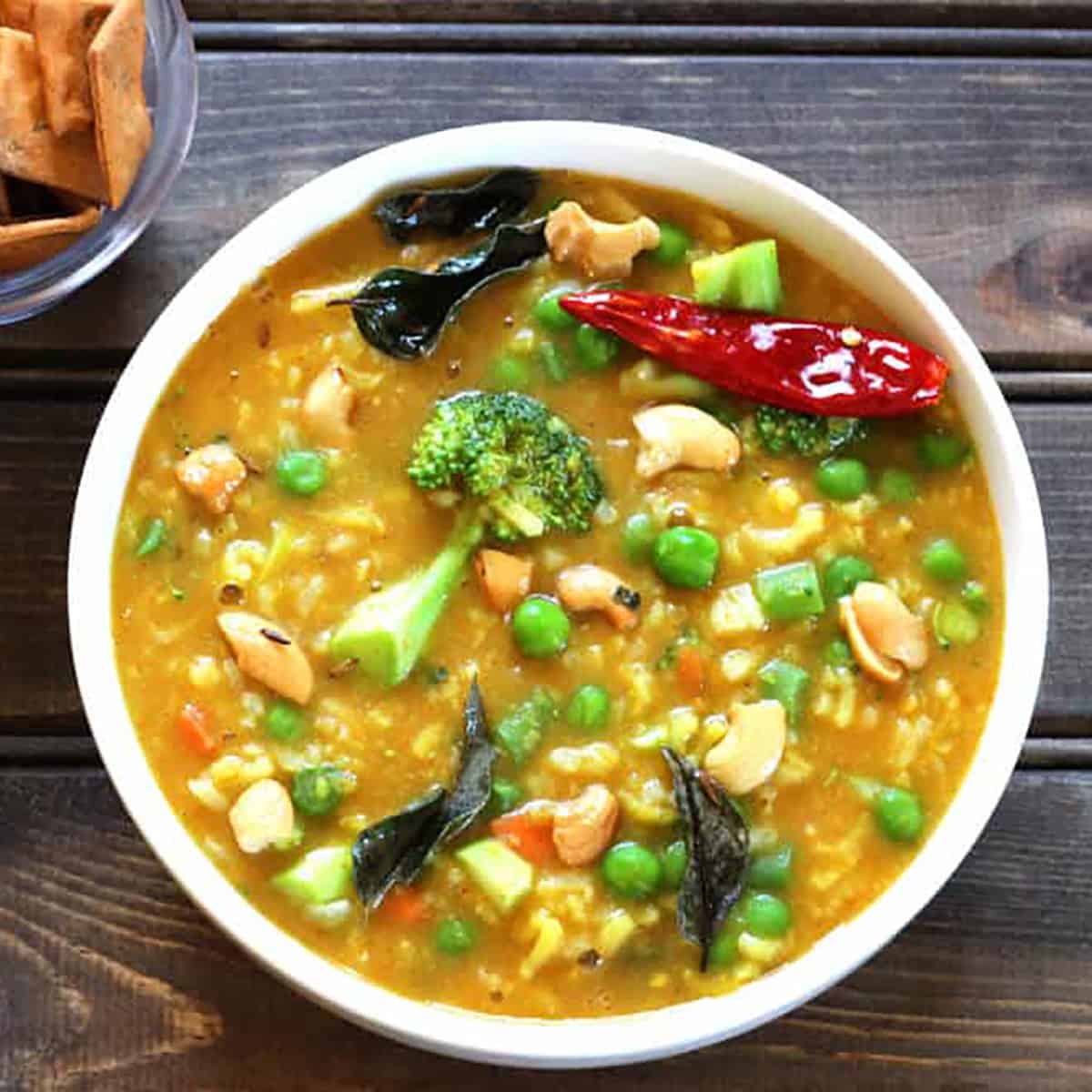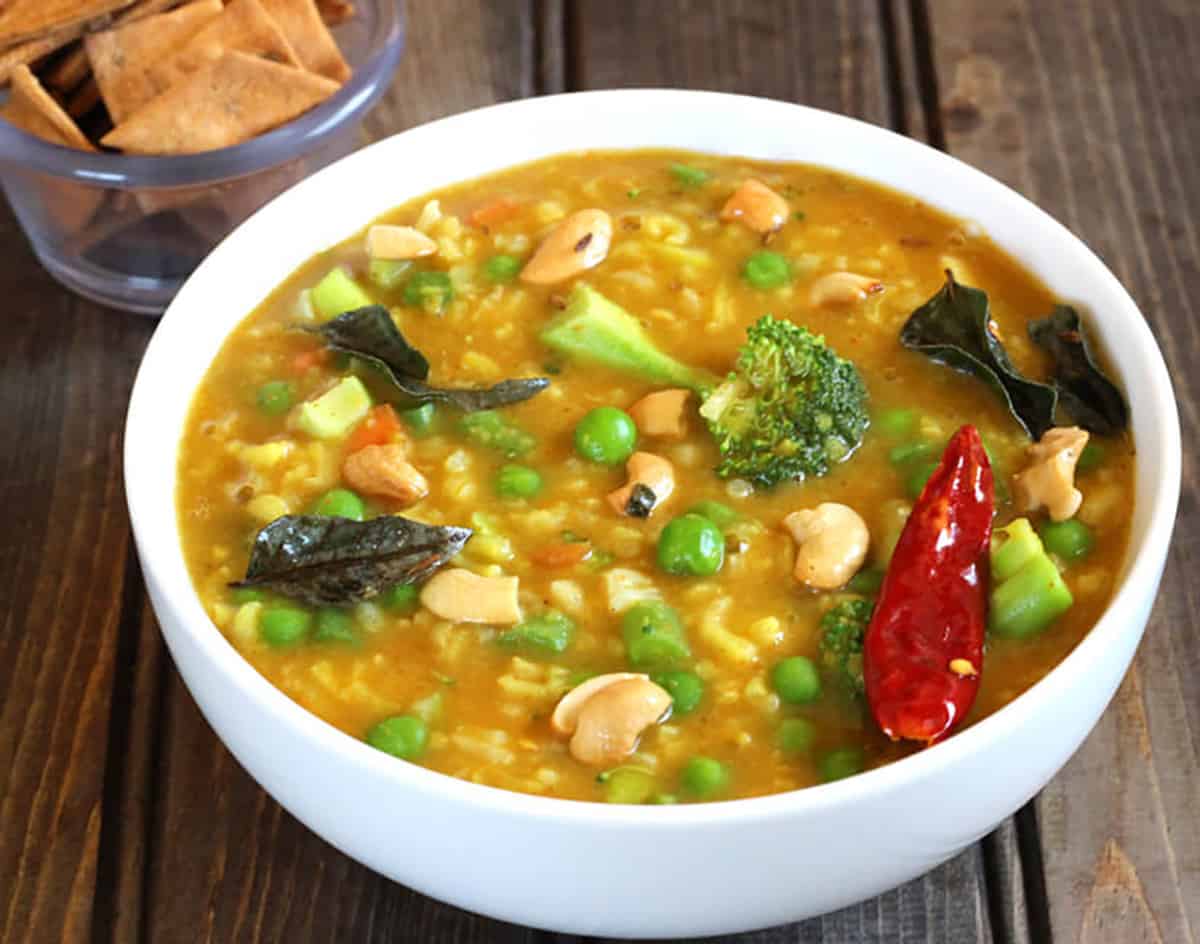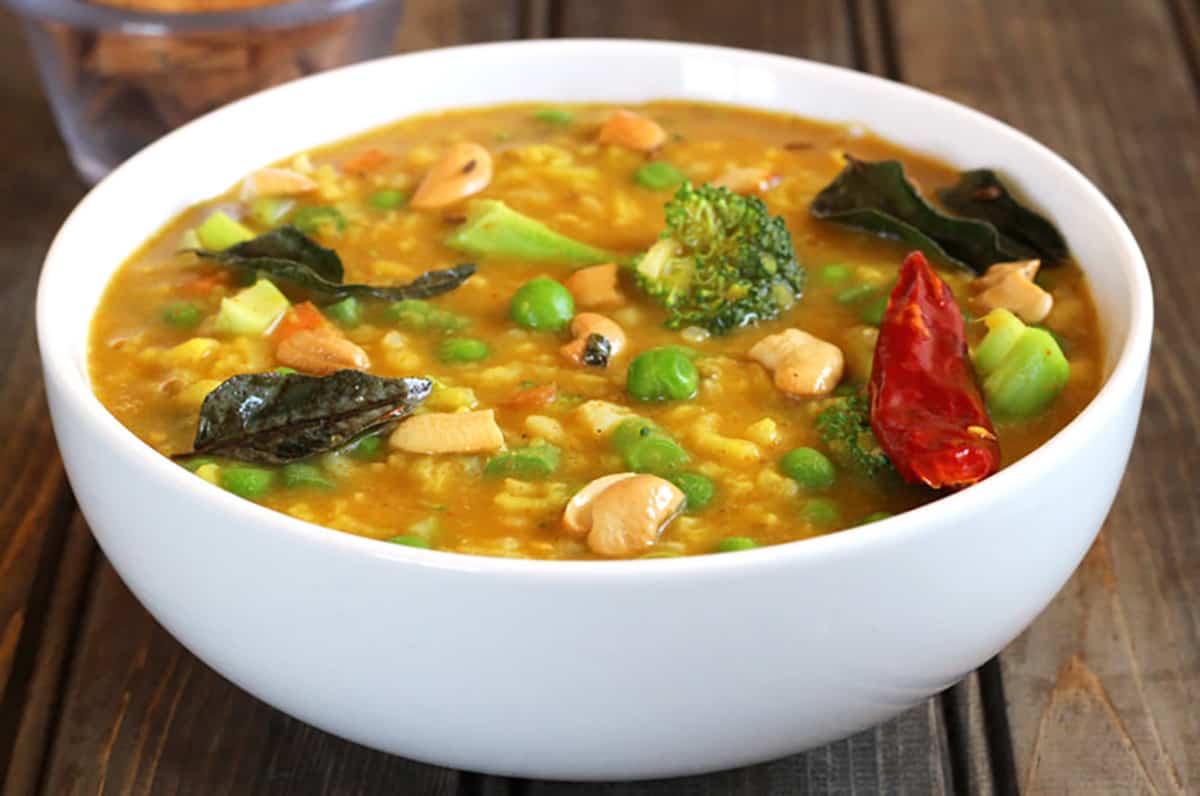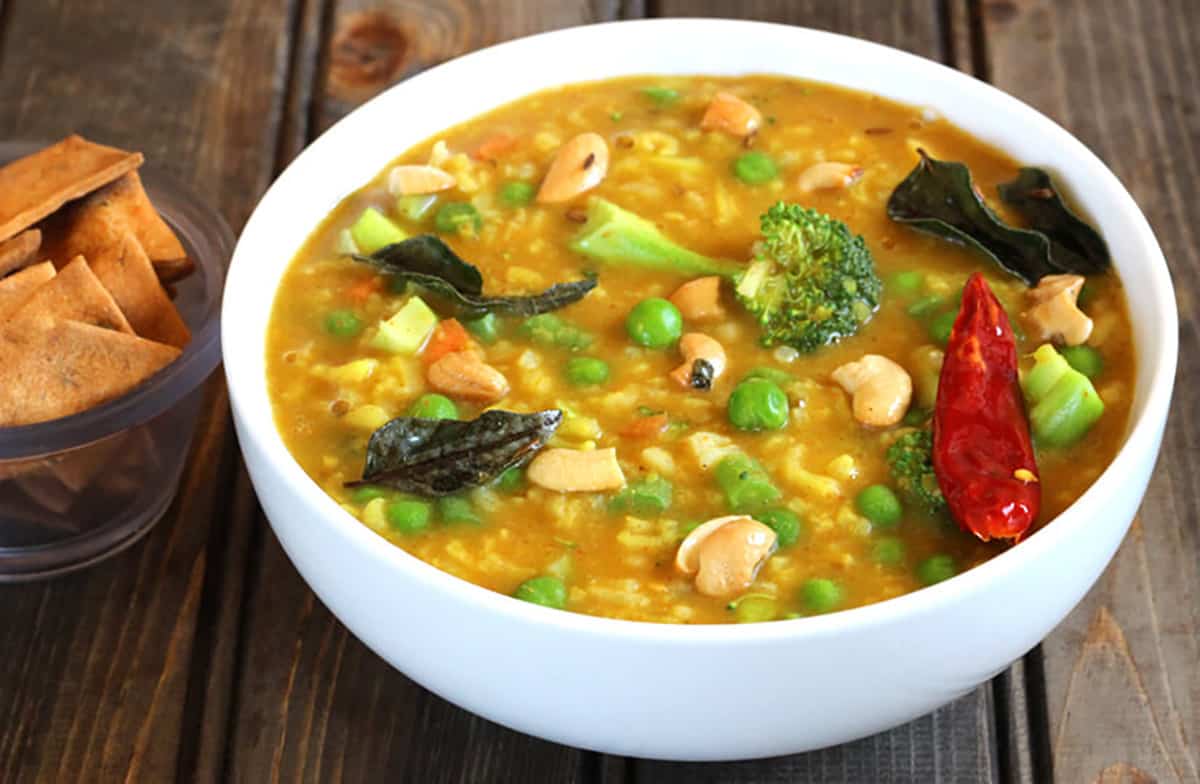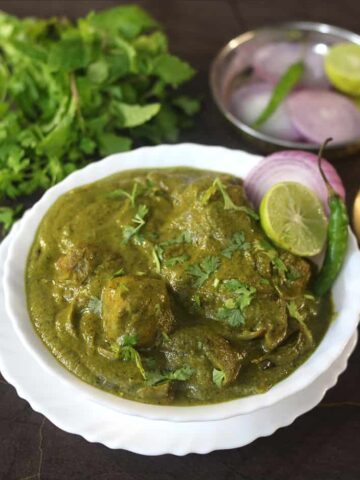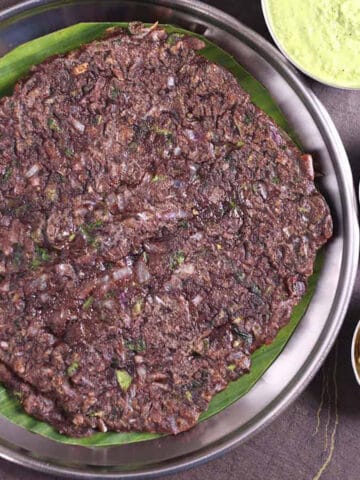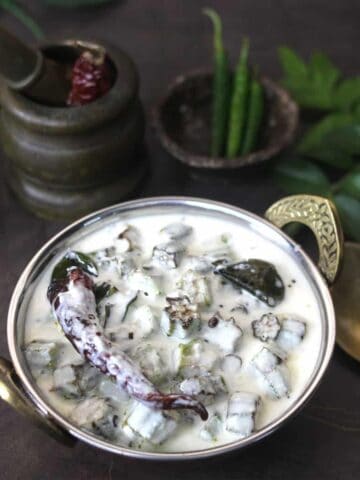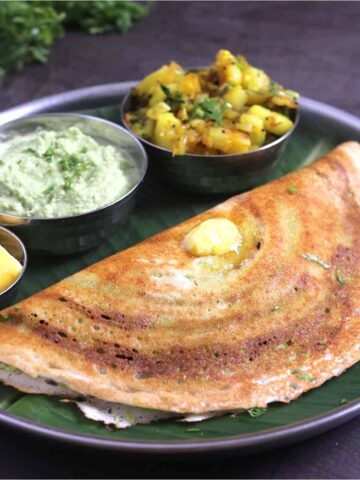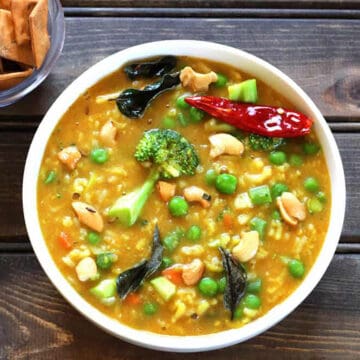Try famous Karnataka food like neer dosa, ragi rotti, sheera, ragi halbai, and chitranna (easy lemon rice).
Why is it called Bisibelebath?
The term bisi bele bath means hot lentil rice dish in English. Bisi means hot in Kannada, bele means lentil, and bath means cooking together. Masala khichdi is very popular in Maharashtra, Gujarat, and Punjab, almost across India, and each state has its variation. The below recipe for masala khichdi is called Karnataka-style bisi bele bath! Bisi bele bhath or khichdi is gluten-free, vegan, and has a low glycemic index which is suitable for diabetic patients. You can serve this dish for breakfast, lunch, and dinner. Make it more nutritious and healthy by adding more veggies and substituting rice with quinoa, broken wheat, millet, or even brown rice. You can make bisi bele bhaat powder at home or use store-bought powder. Mtr powder is the most loved one, and you can use that in the recipe here.
Ingredients
Rice: Traditionally, to make bisi bele bhath sona masuri is used. But you can use any rice, including basmati, jeera, or brown rice. Dal: Toor dal or split pigeon peas (togari bele) is the lentil used. You can get a detailed picture and information on toor dal here. Vegetables: More veggies better the taste and nutrition. Some vegetables that you can use to make bisi bele bhaat are onion, capsicum, beans, cauliflower or broccoli, green peas, pearl onions or sambar onion, squash, pumpkin and carrot. Bisi bele bath powder: You can use homemade or store-bought ones like MTR. I have given the recipe below for bisi bele bath masala powder prepared using aromatic Indian spices. Tamarind: Soak tamarind in water for 15 minutes before using it in the recipe. Traditionally tamarind is used. But if it is unavailable, you use tomatoes or lemon juice. Oil or Ghee: Ghee (tuppa) gives the best results. But to make it vegan, we prefer using coconut oil. Tempering: Cashews or peanuts, cumin seeds, mustard seeds, dry red chile, and curry leaves. See the recipe card below for a full list of ingredients and measurements.
Step-by-step instructions
How to make bisi bele bath powder at home?
Dry roast the coriander seeds on a low flame until crisp and aromatic. Transfer this to a plate. Add dry red chilies, urad dal, chana dal, cinnamon, cloves, cumin, and methi seeds to the same pan and saute until aromatic. Switch off the flame. Stir continuously to prevent burning. Let the spices cool down completely. Transfer this to a blender and blend it to smooth powder.
Easy one-pot bisi bele bath in a pressure cooker
Nicely wash the toor dal and rice in water until it runs clear. Heat coconut oil or ghee in a pressure cooker. Add onion, turmeric, and asafoetida and saute until onion becomes translucent. To this, add all the veggies and saute for 2 minutes. Add 4 cups of water, washed lentils, and rice, salt to taste, and pressure cook on a medium flame for two whistles. Remove the weight once the pressure drops. Open the lid of your cooker and turn on the flame to medium; Add bisi bele bath powder with ½ cup of water in a bowl and whisk to avoid lumps. Add this to the cooked vegetables and lentil mixture, soaked tamarind water, adjust the salt, bring it to a boil, and simmer to absorb the flavors very well. This thickens faster, so adjust the water to desired consistency.
Make the tempering
Heat coconut oil in a pan. To this, add mustard seeds and cumin seeds. When the mustard seeds splutter, add cashews, curry leaves, and broken dry red chile and saute until cashews become light golden in color. Add this tempering. Serve hot with boondi or chivda and raita or yogurt salad, and enjoy.
Tips
You can substitute rice with quinoa to make quinoa bisi bele bath or even with brown rice, millet, or broken wheat. Vary the spices as per your taste. Feel free to use store-bought powder from Mtr or GRB or Maiyas. Adjust the amount you add. If you like it spicy, add red chili powder, slit green chile, or pepper powder as per your taste. You can substitute coconut oil with butter, more ghee, or vegetable oil. If you do not have a pressure cooker, you can prepare this dish in a pan. But it’s time-consuming. You can soak the dal and rice for 30 minutes to reduce cooking time. Use any vegetables of your choice. You can add potato, eggplant, or zucchini. The more veggies, the more nutritious it is. This dish thickens as it cools down, add little water and warm up the dish before you serve. To balance the sourness and spiciness, add 1 teaspoon of jaggery. Skip onion to make it a no onion, no garlic recipe. To make masala khichdi restaurant style, you can cook dal, rice, and veggies separately and mix everything at the end. This method makes sure that rice is not mashed and vegetables are cooked but not soft. I do not try this as it is time-consuming and requires too much vessel cleaning.
Instant pot bisi bele bath
Turn on the saute mode of your instant pot. Add 2 tablespoon of oil to your IP. Add cashews and saute till it becomes golden. Transfer this to a plate. Add mustard seeds and cumin seeds. When they splutter, add curry leaves, dry red chile, onion, turmeric powder, and hing, and saute until the onion becomes translucent. Add the veggies and saute for a minute. Add 4 to 5 cups of water, rice, and dal, and deglaze the bottom of your IP. Press the cancel button. Secure the lid of your instant pot and see that the pressure valve is in the sealing position. Pressure cook for 8 minutes. When the IP beeps, Let the pressure release naturally for 10 minutes. Then release any pressure manually. Open the lid, and turn on the saute mode of your IP. Add bisi bele bath powder with ½ cup of water in a bowl and whisk to avoid lumps. Add this to your IP along with soaked tamarind water, adjust the salt and water for desired consistency, and bring it to a boil. Press cancel and turn off. Add roasted cashews and Cilantro and mix. Serve hot, and enjoy.
More South Indian Recipes
Did you like this recipe? Please leave a star ⭐️⭐️⭐️⭐️⭐️ rating below and/or a review in the comments section. You can also stay in touch with us through social media by following us on Pinterest, Facebook, Instagram, and Twitter.
Recipe card
